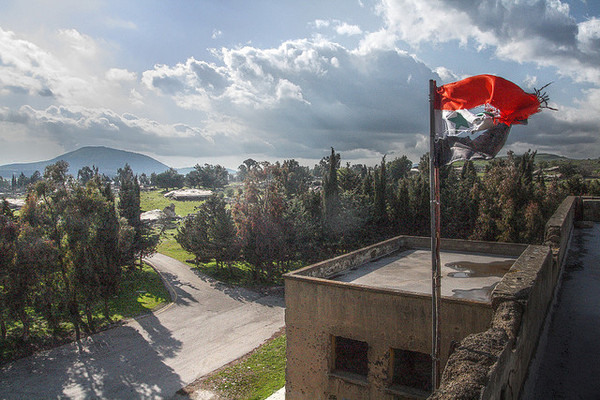Al-Quneitra is the capital of the destroyed Governorate which is located to the south-west of Syria.
The city is situated in a valley in the Golan Heights at an elevation of 1,010 metres above sea level. The name “al-quneitra” means ( the little bridge).
On June 10, 1967, the Israeli enemy destroyed al-Quneitra and displaced its people from their lands like the other Golan’s villages.
Quneitra is situated in a valley in the Golan Heights at an altitude of 942 m. The surrounding area of the city is dominated by ancient volcanic lava flows punctuated by a number of dormant volcanic craters which rise some 150–200 m above the surrounding plateau.
The volcanic hills of the region have played a key role as observatory posts and firing positions in the conflicts over the region, most notably in the October War. In peaceful times, the fertile volcanic soil has supported agricultural activities such as wheat growing and grazing.
During his visit to the region, the American traveller Harriet-Louise H. Patterson recorded that Quneitra was charmingly set in a grove of eucalyptus trees. Al-Quneitra is pleasant as a stopover for lunch. It is cool under the spreading trees, usually quiet and restful.
The city’s position on an important trade route gave it a diversified population for much of its history. By advent of the 20th century , its population grew to some 21,000 people after the Syrian independence from the French occupation in 1946.
Al-Quneitra in History
 The surrounding area has been inhabited for millennia, where excavations works had been discovered that Palaeolithic hunters are believed to have lived there. A settlement was established at least as early as the Roman and Byzantine times, serving as a stop on the road from Damascus to western Palestine. Saint Paul is said to have passed through the settlement on his way from Jerusalem to Damascus where St.Paul was converted to Christianity in Kokab village, north-east of Quneitra, on the road to Damascus.
The surrounding area has been inhabited for millennia, where excavations works had been discovered that Palaeolithic hunters are believed to have lived there. A settlement was established at least as early as the Roman and Byzantine times, serving as a stop on the road from Damascus to western Palestine. Saint Paul is said to have passed through the settlement on his way from Jerusalem to Damascus where St.Paul was converted to Christianity in Kokab village, north-east of Quneitra, on the road to Damascus.
In 1868 a travel handbook reported that the site was a “ruined village of about 80 or 100 houses” and a large khan also stood in ruins.
Towards the end of the 19th century, the modern city grew around the old Khan which had been built using the stones of a ruined ancient settlement. In the midst of 20th century ,Quneitra became the administrative center of Golan.
During The World War I, the Australian Mounted Division and the 5th Cavalry Division defeated the Ottoman Turks there on 29 September 1918, before they took Damascus. Quneitra witnessed several battles during the Syria-Lebanon Campaign of The Second World War, including the Battle of Damascus .
When Syria and Palestine gained their independence from the French and British occupation respectively after the Second World War, Quneitra gained a new strategic significance as a key route junction some 15 miles from the border thus becoming a prosperous market in the region .
 During the first few days of the October War in 1973, al-Quneitra and many villages of the occupied Golan Heights had been restored to homeland, Syria.
During the first few days of the October War in 1973, al-Quneitra and many villages of the occupied Golan Heights had been restored to homeland, Syria.
On 26 June 1974, the late president Hafez Al-Assad hoisted the Syrian flag on the liberated Quneitra .
The directives of H.E President Hafez al-Assad since the liberation of Quneitra to restore life to this governorate stressed providing all elements of the steadfastness of its people and raising the slogan of reconstruction is conductive to liberation.
Al-Quneitra undertook the responsibility to achieve these accordingly:
1- The Structural and productive level: to rebuild what was destroyed by the Zionist machine in all liberated villages and provide them with all the services. Among which the agricultural land reform and make it available to citizens to return to their villages at the expense of the state.
2- The social level: to stabilize people’s life and support their steadfastness for the development of economic , cultural and political fields. Besides, the development of agriculture in both areas flora and fauna , and provide basic services in the field of education.
M. Wassouf

